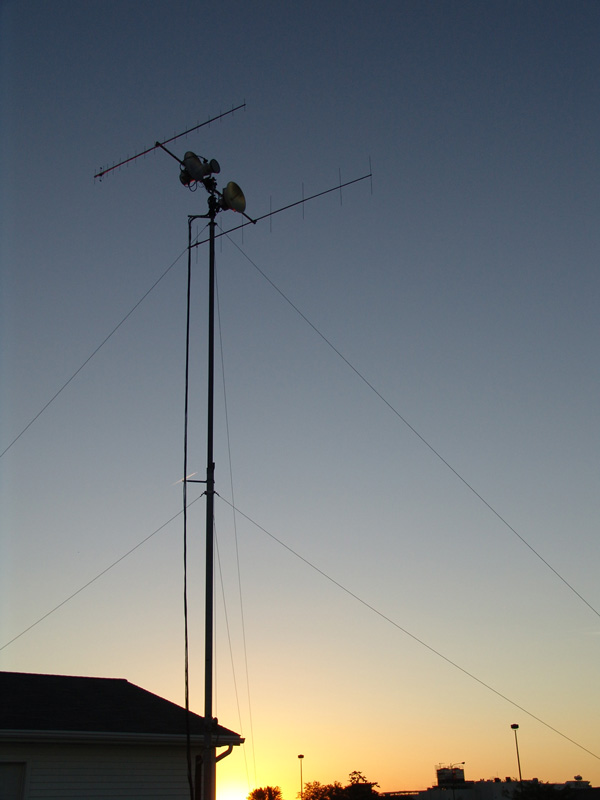
ARRL 2007 UHF CONTEST AT KMØT
and Rover Mania IV

The UHF Contest of 2007
What was the story behind the UHF Contest of 2007 at ARS KMØT? Well, I'm really not sure. The year went by so fast I had little time to give it much thought, having to be on autopilot until the weekend of August 5th. We had lots going on here with the family and work, so when I had time to work on radio stuff, things seem to fall into place for the most part.
The end of the 2006 contest brought relief, as the station held together and the SDR-1000 IF radios did what they were supposed to do. More relief was experienced a few months later after the final scores were posted, as it was a close one! WW8M, Don gave me a run for my money here. One more QSO or multiplier was the difference in the final scores, really too close for any comfort level! Great job to Don and all that participated over there!
So the thought process began on what to do for the next UHF Contest – or RoverMania IV. One night while I was pondering the strategy and wondering who might be roving and where, I could hear someone getting sick in the bathroom. Well wouldn’t you know it, the wife was sick. Hmmmmm…I thought, not a big deal…until it lasted for a few weeks J
With Harmonic #4 confirmed a bit later with a September due date, Colleen continued to be pretty sick. We spent a good 4 months with her laid up in bed whenever she could. With the other little gremlins running around, not much time was had until I could get them to bed, and then normally I was pretty bushwacked.
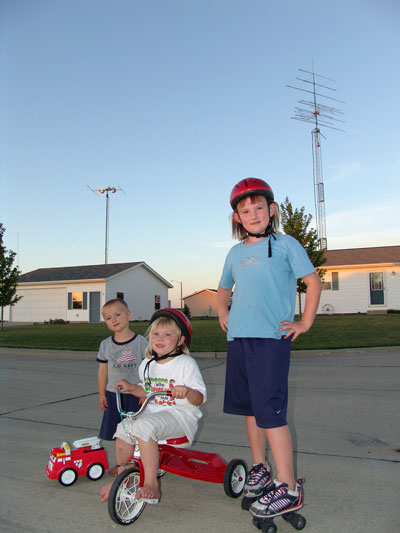
Our Gremlins...Man they grow up fast....
Work at EDA had been crazy since June of 2006. Our company began having consistently more work than we could all handle. This incidentally continued into 2007 and is still going strong. We needed to make hay while the sun shined in the commercial construction industry, so we had to keep our noses to the grindstone.
So, with the extra work hours, pressure at home and a do list of other microwave related projects, I needed to keep it together somehow. Where to begin, where to begin……
Fix Broke Stuff
Not a lot was broke however. My microwave tower rotor, the Alfa Spid, had a relay problem in the control box. The boys at Alfa Radio in Edmonton sent me a few spare control relays and I simply replaced the bad one. It has worked fine ever since. Great customer service at Alfa Radio, as they sent me the replacement free of charge! See www.alfaradio.ca
I also had to fix my hand held PTT button, not a big deal. Really I did not have much to do unless I was thinking of additional overhauls or improvements.
222 MHz upgrade
I decided to get a new 222 MHz amp to configure with my DB6NT 222 MHz transverter. I had not yet used the transverter, so I was looking forward to checking it out. The amp I obtained was a TE Systems 2252G, good for 200+ watts with 15 watts input.
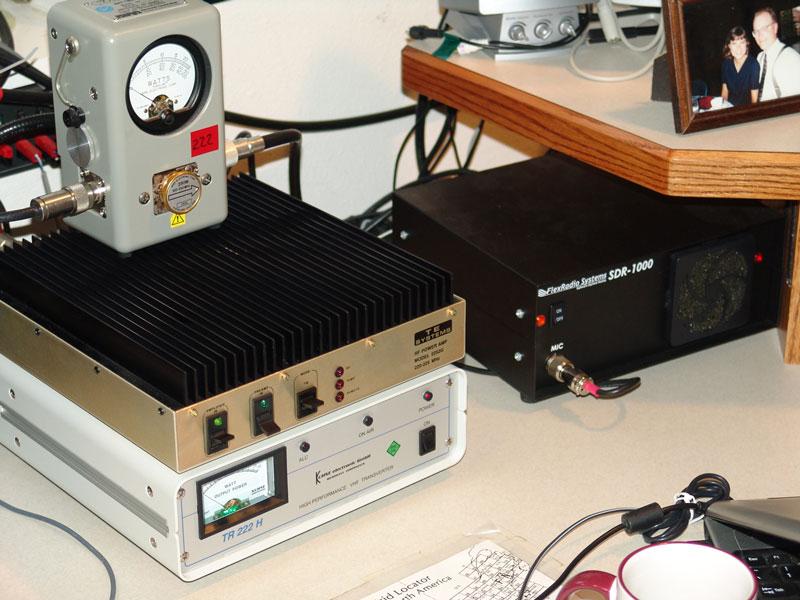
New TE Amp and the DB6NT 222 MHz transverter - SDR-1000 IF at 29 MHz
The idea here was to interface with the new Flex-Radio Flex-5000A. However, as time passed, it was evident that the new radio would not show up in time. So plan B was implemented. I decided to disconnect my SDR-1000 #1 dedicated to my 6 Meter transverter and then hook that up to the new 222 MHz transverter / amp. That way I could run 222 MHz on SDR-1000#1, 432 MHz on SDR-1000 #2 and SDR-1000 #3 would do the 902 MHz through 24 GHz as always.
A bit of messing around hooking things up got the setup rolling a few day before the contest with all working well. All the above was not too time consuming and did not manage to get in the way. However, there was one other chunk I bit off that almost did not get done.
Breeding Microwave Rovers….
Arliss, W7XU from the other half of EN13 had roved during the recent June Contest with Ed – WØSD. They seemed like they had a good time and actually got to stop in and see me during the contest. Afterwards, I asked Arliss if he would think about going out for the UHF contest. He said he had not done microwaves before really, but he was willing to give it a try. With that, I began to come up with a plan to get some additional bands for him and Ed.
I had some spare gear, but not up to snuff as far as in a “package”. The loose equipment consisted of a DEMI 902 – 10W transverter, a 100 watt 1296 Amp, my spare 3456 MHz 15 watt DB6NT setup, a 112 Element looper for 3456 MHz and my 5.7 / 10 GHz dual band dish. I also had the PyroJoe 30 watt 2304 Amp project sitting in pieces in a box.
I did not have lots of time, and what I was missing was a 1296 MHz and 2304 MHz transverter. DEMI at this time was in the process of moving their entire operation, so a call out to DB6NT resulted in only a 1296 MHz transverter. They were in the process of changing over to their new line of Mark IV transverters, so no 2304 MHz equipment was in stock.
A general post to the internet resulted in Lloyd, NE8I having a spare 2304 MHz transverter, so that worked out great! Thanks Lloyd!
I had the parts, I had no time, it was mid June…I had to buck up and get er done….
Let the Building Begin…
First off was to work on the 2304 amp from PyroJoe. The board was rated for 30 watts out with very little drive. It also came with a bias board to control the amp. Joe helped me with a few pinout questions and I began planning the layout for being inside a Motorola paging amp enclosure. I got the idea from Jon- WØZQ, who had put equipment inside of these enclosures in the past. It was a neat idea as with the carrying handle and all, made it quite portable.
I ripped out the old boards and tried to save as much as I could, like the feed through connector board from the RF section to the control section.
I then grinded away with the old Dremel tool for the connector plate. This was made of fairly soft pot metal, so that worked out pretty well. Actually having this plate removable made it easier to assemble.
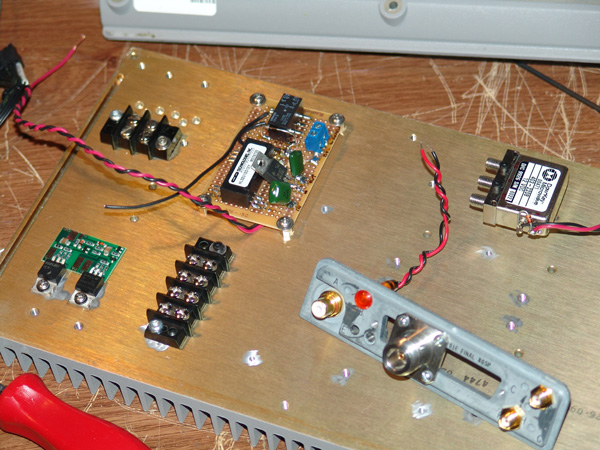
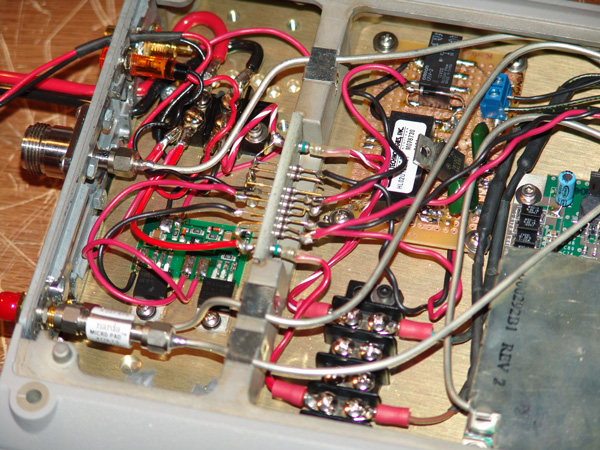
2304 MHz Amp Project - 24V bias and control board built on the perf board...
After laying out the amp board, TR relay, bias board and TR relay, I was able to mark the holes and begin drilling and tapping the heat sink. This I gave lots of thought, as I arranged the components, then rearranged again to get the best layout that allowed access as well as minimized feedline issues. What I came up with was not the easiest to build, but seemed to be the best overall layout.
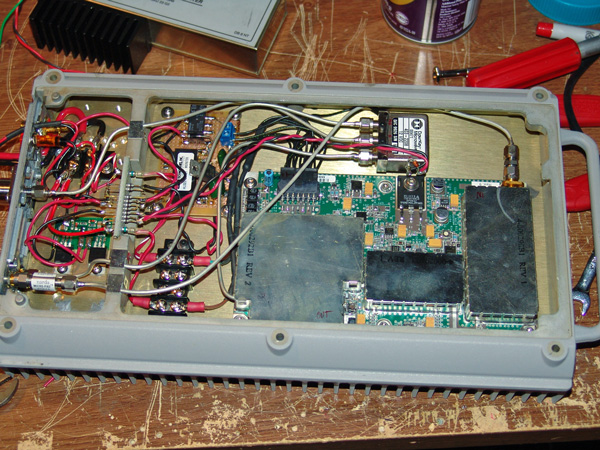

Assembled amp and 2304 MHz transverter courtesy of Lloyd - NE8I - He came through big time!
After getting it all assembled and hooked up, good power was the result. The amp had no problem producing 30 watts at 2304 MHz, with less than 10 dBM of drive. In fact as you can see from the attenuators, I had to bring the output of the 2304 transverter down quite a bit.
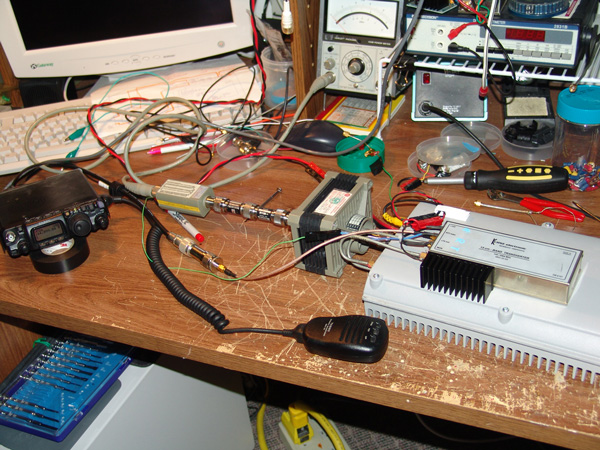
Final testing and setting drive levels...
With that all done and tested, it was off to the 1296 MHz setup. To make things simple, the DB6NT 1296 MHz transverter puts out +12V during TX to drive relays, etc. This I hooked into the DB6NT sequencer, which in turn also puts out 12V to control a TR relay, but in a sequenced fashion. This I used to drive the SSB TLA 100W amp. The PTT input on the amp was settable to either positive +12V or to ground for PTT. That made it all very easy and I wired up the sequencer in a small box.
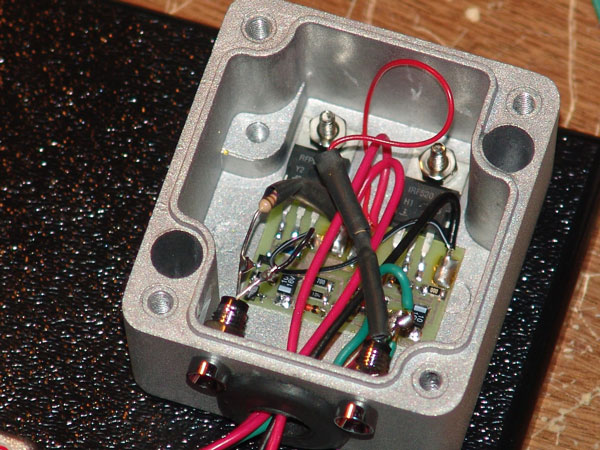
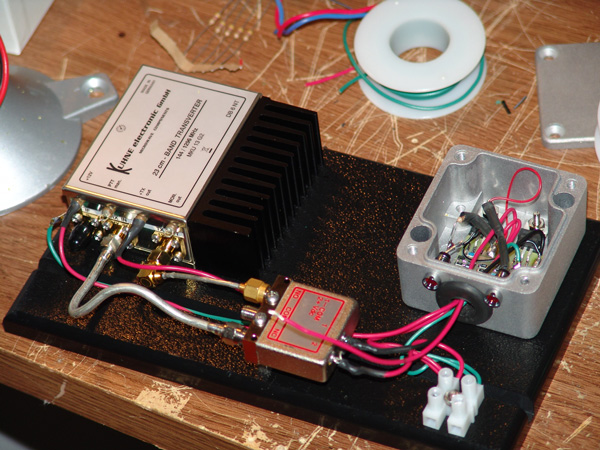
Sequencer wiring and 1296 transverter with TR relay...nice and compact...
I then found an old piece of plastic that I had rat holed some time back. Those are the moments a guy loves, where you sit back and think about something and recall that you have some piece of junk lying around that might just work…just how do you find it J
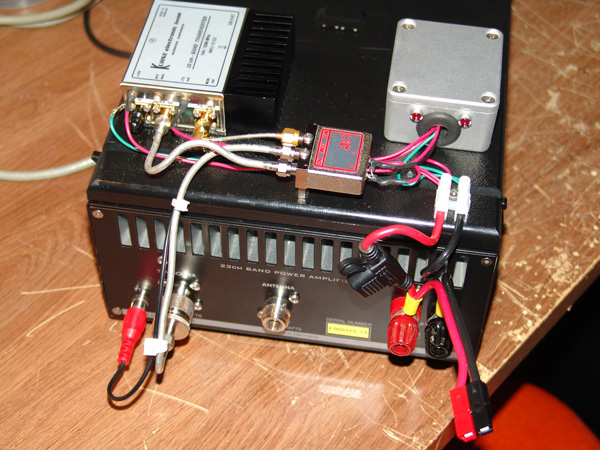
Final setup with transverter / sequencer strapped to the amp...
Well, the piece of plastic was again located and cut to the width of the TLA amp. From there I drilled holes to mount the transverter and sequencer box. The beauty of it was that the plastic was thick enough to counter sink the screw so It would not scratch the top of the amp. That all got tie wrapped to the amp and hooked up for testing…good for almost 100 watts at 1296 MHz!
At that point, the 902 transverter and 15 Watt 3456 MHz box was broke out and tested. All was good to go.
Rover Rack design…
After the piles of tested gear was spread all over the ham shack, I began to think about how all this stuff should be put together for ease of portability. I knew we were getting close to being out of time, so the idea was to put it all on one rack, hook up power, feed lines and be good to go.
Taking a look again at my shack transverter rack I built a few winters ago made me make another trip to Menards to check out the shelving area. There I found again the same wire shelves, but in 18” x 18” square form. Hey, that looked just about right. So I got 4 posts and 3 shelves to bring home.
After some studying of the equipment sizes, a layout began to emerge and the result was that the shelves were still far enough apart to be able to get to things.
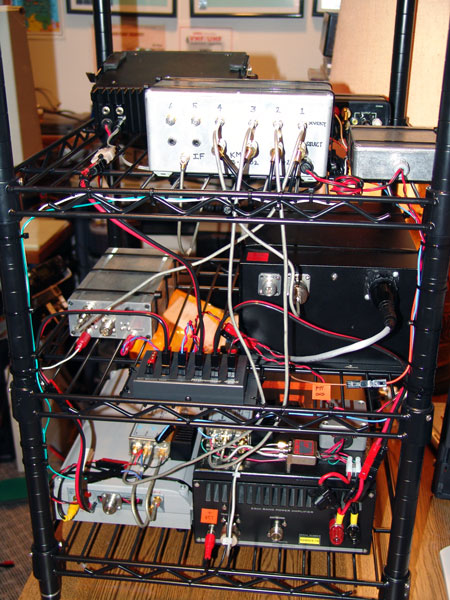
Rear view of the portable 4 band rover equipment rack...
After the gear was mounted, the Rig Runner was installed to do the power distribution. I then broke out an old IF switch and AV switchbox to figure where that was going to go. I then had to rig up a 12V to 28V converter for the IF relay box, not a big deal because I had a spare unit. Got these off of eBay, they work really nice.
I got an IF radio – Kenwood TR751 from W7XU. I got into that and adjusted the drive levels to give me 1 watt on the low power and 1.5 or so on the high power setting.
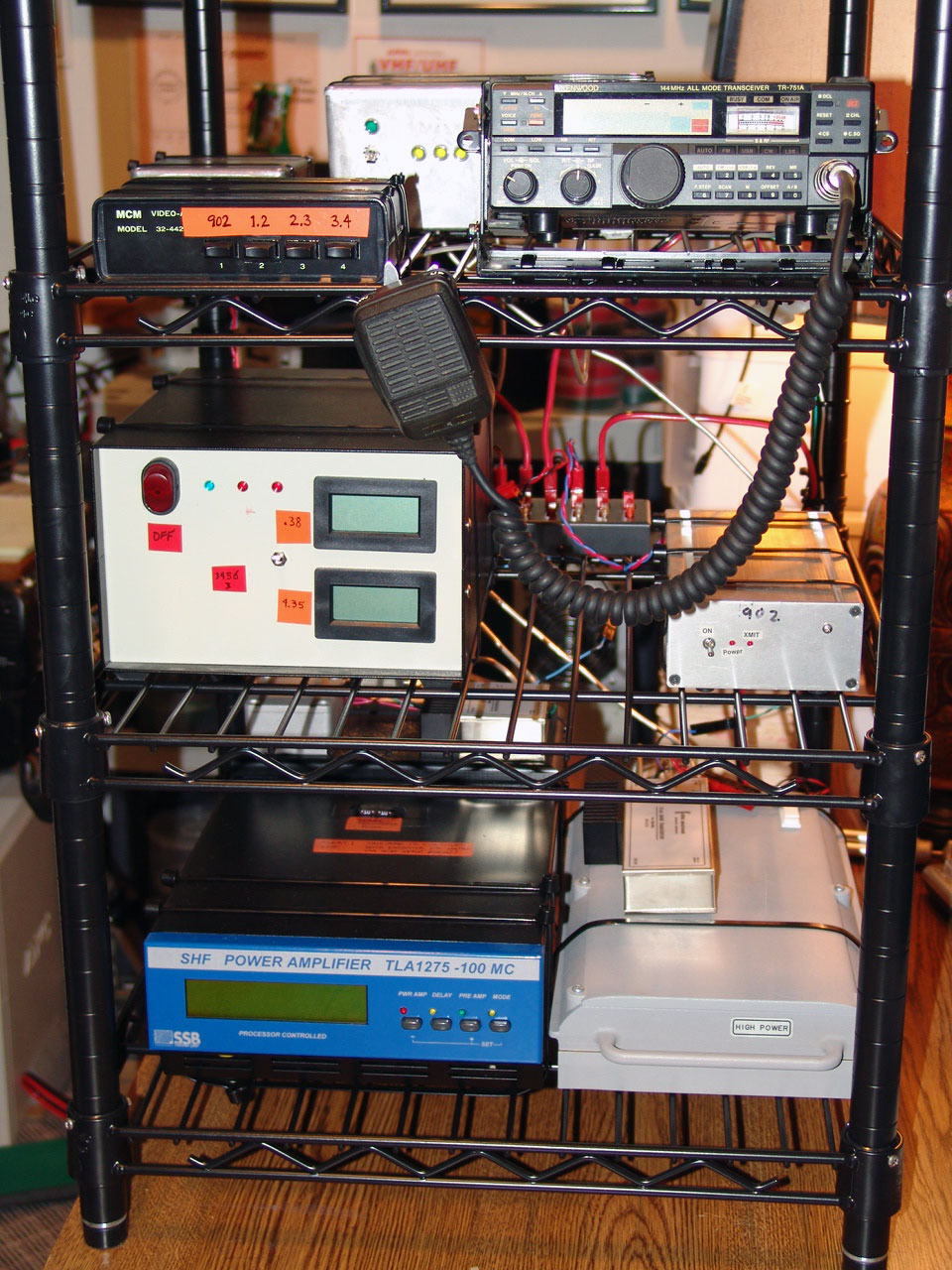
Front end of the 4 band rover equipment rack. Add 12V and feedlines to antennas....your ready to rock and roll!
Testing…one…two....uh oh….
After getting all the connections made in the rover rack, testing went well with 902, 1296 and 3456. However, after checking 2304, I noticed that the output was wavering in somewhat of a periodic fashion. When I let up on the PTT, the S-meter on the TR-751 was also wavering up and down. Odd I thought, so I hit it again, I was then getting solid power output, but on RX, there was no longer any S-meter reading…..not good.
I guessed that I had blown the RX front end GASFET somehow in the 2304 transverter. With only a quick week and half to go, this was not good. I removed all the 2304 equipment from the rack to bench test it once more. Same result. A test of the PTT circuitry and sequencer did not reveal any issues either.
I had a few spare NEC NE32584 HEMTs, so I replaced that device. Nothing changed, still no RX noise. I was now a bit out of my league. With that, a call was made to Gerry at SSB Electronics for a bit of guidance. Gerry was very helpful as we talked through the problem. He thought since we had no RX after the HEMT was replaced, that the pin diode switch was damaged. He indicated that the pin diode switch on the IF side could have gotten damaged.
I told him where my power levels were, but I then recalled when I was testing, that I had hit the “high” and “”low” button a number of times to see how much the drive level effected the final 2304 output. Gerry suspected that in that particular TR-751, that the ALC did not recover quick enough when switching between the two power levels and was hitting the IF input with 25 watts for a brief moment.
I was testing the BAT pin diodes as best I could and it did indeed appear that one of them was open on RX when it should have been conducting in order to let the RX signal get to the IF RX side. I found a pf value capacitor in the junk box and held it across the open diode. Sure enough, the IF noise for RX came alive!
Gerry was good enough to dig through his parts there and was able to mail me one pin diode to do the repair. I got it a few days later and got it soldered into the circuit. It was a very small device, so it was a bit nerve racking but all went well and the transverter tested fine on receive.
From there, being a bit scared of using the TR-751, I switched that out to my spare FT-817 and reset the levels. The rover rack was ready to go!
A bit of trolling on eBay after that resulted in obtaining some spare parts for the DB6NT transverters. NE32584s, BAR64-03W pin diodes and LL4148 switching diodes. Always good to have spares!
With Arliss having the rover rack, and the bands he already had, he was going to be ready on 222 thru 3456 MHz.
The Homefront:
After all that building was done, I was taking some mandatory vacation visiting the folks up in Minnesota. The schedule was going to be such that when we got back the contest was going to be only 4 days out. So I needed to get it all done before we left.
Usually, we attend the Central States VHF Society conference during this time, but our doctor indicated that our travel window for being that far away was closed, so a trip to San Antonio was not in the cards for Colleen being where she was with the pregnancy.
But again, we were able to get a few hours away to Minnesota. Lots of family and friends were visited. Lots of swimming was in order for the kids at the local lake, as it was excellent if not very hot weather the whole week. It was good to get unplugged for a bit and spend some good quality time with the family.
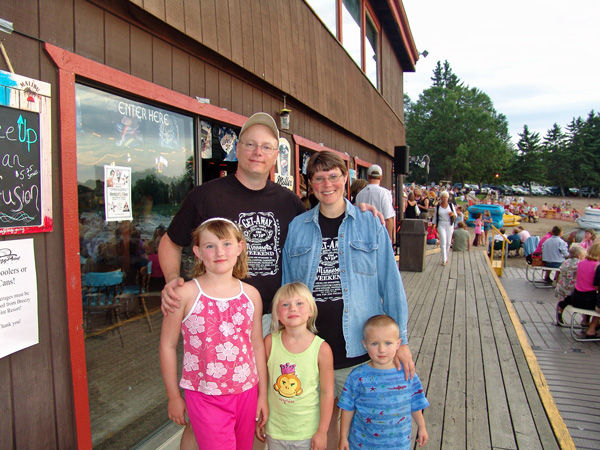
Dockside Lounge in Breezy Point, Minnesota
The exact spot on the dock where Colleen and I met in 1995..
Now look what happend!
10 GHz Gridfest…
The weekend before the Central States conference, Jon – WØZQ and his XYL Barb were going to be making their way down to San Antonio, perhaps hitting a few grids down the way. That way I could maybe pick up some new grids and Jon could get some VUCC/Reverse grids. Since Jon had been using one of my 24 GHz portable dishes, he indicated that he would drop that off at the house on his way down since he knew his rover route for Rovermania IV would not bring him close enough to use. I thought about this and said sure I will take it back and perhaps get that to W7XU as well. However, we happened to have to run up to the cities for a day before he left, so I was able to pick it up myself, that way he would not have to haul it on his trip to the conference.
Anyway, as Jon made his way down south, he turned west and kept going. We worked in a number of grids, having some good tropo at the beginning. It then seemed to all shut down for a few grids, which was not good as these were rare new ones! In the afternoon, we then got some storms and I was able to pick up some long haul grids via rain scatter. We even chatted on FM from the last two. In the end, it was a lot of new reverse grids for Jon and 6 new ones for me!
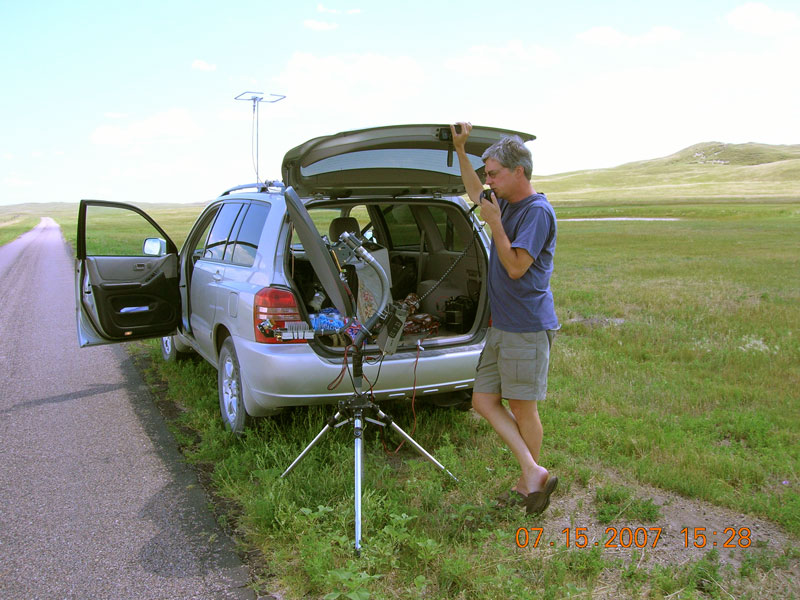
WØZQ chatting with me on 10 GHz FM from DN81tx! Just your typical 325 mile 10 GHz FM QSO...

RainScatter screen shot with WØZQ in DN82...nice that the WX cooperated!
Thanks Jon for running a bit off your path to the conference!
Final setups…
Gene and I got together and I was able to do a few maintenance items on the portable 24 GHz dish setup he was using. Over the years, we had discovered that the FT-817 IF would show the “High SWR” icon on occasion. Jon – WØZQ - had discovered this on the unit he was using and determined that the FT-817 was not sinking enough current to drive the PTT for the whole setup. So he interfaced a relay that would be driven by the FT-817, but the PTT for the dish equipment would be PTTed directly to ground via the relay contacts. This seemed to work great and I updated Gene’s dish the same way, problem solved.
I also took the ID Electronik 124.25 MHz OCXO out of each portable setup and reconfigured the hook up so I could get to the adjustment screw on the OCXOs. That way after a long warm up, I was able to adjust them so that 24,192.100 was within a few KC of the “real 100” based on my GPS locked 24 GHz signal source.
When Gene came back to get the work done on the 24 GHz dish, I also got my dual band 5 & 10 GHz dish back from him. He had been taking that out portable on occasion and would give me a call if he happened to be in a new grid somewhere. It was nice to have it home, but I slapped W7XU's name on it for the upcoming contest. Also, now that I had back the portable 24 GHz dish I had borrowed to WØZQ, that could be borrowed by Arliss as well.
W7XU Testing:
Days before the contest, Arliss came to pick up the pile of gear. We had a nice chat during the afternoon and went over all the equipment, operation, etc. It wasn’t long and he was ready to test out the gear.
All the low bands went good, and then off to the dish bands. I noticed on 5 and 10 GHz that he was very wide and had some light distortion. Sure enough a check of the radar indicated there was a bit of afternoon weather brewing between us. It was very minor, but enough to make a difference.
We got to 24 GHz and banged away for a bit and was able to see his signal. After we got lined up and worked on some weak CW, I told him to tweak his dish up a bit and around on my signal. Boy was he surprise to be doing rain scatter on 24 GHz and the signals were really pounding in. Not bad for a first go at it, piece of cake. I hoped that he understood that it’s normally not all that easy
The Contest:
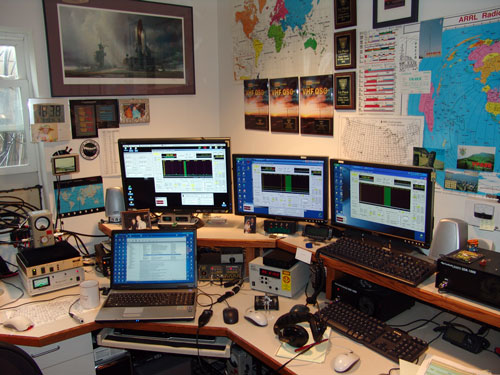
The KMØT Shack - UHF 2007 - Three SDR-1000's IFs Get a Work-Out!
As far as the contest goes, activity appeared to be way down. But as I think back, this was due to the weather for the most part. There was plenty of dead time for most of the contest, as I worked only 50 non rover QSOs. Those 50 contacts were between 16 individual stations; with 8 of those stations consisting of 2 or less contacts. Propagation was not good. There was considerable rain NE of here and it shut down a lot of the EN34 area as well as potential Wisconsin and Michigan contacts. It also affected direct paths to the east, where there were other fixed stations and other rovers.
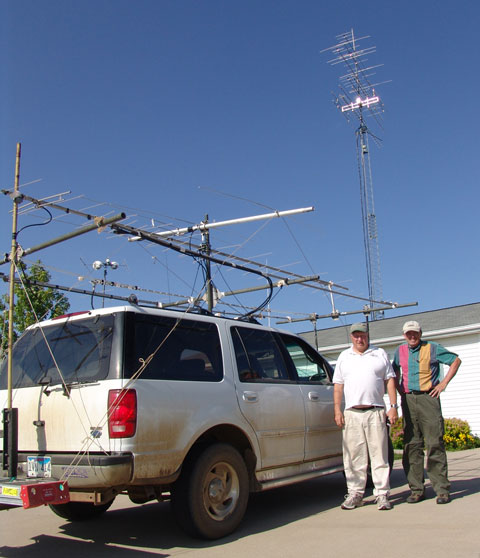
W7XU/R with WØSD - A quick stop over during the June 2007
Contest - sorry no pics from the UHF 2007 contest
Highlights were of course tracking rovers, and listening to W7XU/R - Arliss and Ed’s surprise from far away grids on the microwaves as the signals rolled in. It is amazing what you can do with just 5 watts on 902 MHz when you get pointed correctly! After about 4 or 5 grids, they really got the hang of it and that helped. Because as they got way north, it was good to have knowledge of how each other operated, as the signals were not good and in and out of the noise. Veteran rovers like NØDQS/R and WØZQ/R were like shooting fish in a bucket, even though both were wet most of the time from the rain. I think Jon was pretty much a drowned rat the whole contest, and did experience water related equipment problems. It was neat to run into Chris - NØUK and Holly - KØHAC, as they ran around using her call as the rover, with a neat set of bands to activate. Thanks for your efforts!
The rain did do some good however, as I did catch Jim - KØKFC in EN35 on 10 GHz rain scatter. He was calling CQ and I just happened to see him pop up on the bandscope! I managed also to catch NØDQS/R random on 10 GHz rainscatter, but it turned out that he was in a grid I had already worked him in. Gene did not manage to make it to more than 4 grids, as he ran into some very bad storms and it shut him out for half the day on Saturday. He never made it back out the next day. W7XU/R – Arliss and Ed ran the north south path west of the front where the rain was, so they really did not have any issues. Luckily for me as they were the main contributor to my score! The Flex-Radio SDR-1000 IF radios ran flawlessly and were again instrumental in the contest effort!
|
Band |
QSOs |
Pts |
QSO Pts |
Grids |
|
222 MHz |
41 |
3 |
123 | 24 |
|
432 MHz |
44 |
3 |
132 | 22 |
|
902 MHz |
33 |
6 |
198 | 22 |
|
1296 MHz |
38 |
6 |
228 | 22 |
|
2304 MHz |
28 |
12 |
336 | 22 |
|
3456 MHz |
27 |
12 |
324 | 22 |
|
5760 MHz |
26 |
12 |
312 | 21 |
|
10 GHz |
30 |
12 |
360 | 21 |
|
24 GHz |
4 |
12 |
48 | 4 |
|
Totals All Bands |
271 |
|
2061 |
180 |
KMØT CLAIMED SCORE: 370,980 SOHP
Well, the robot docked me a QSO - not sure why...so the official score on the ARRL website was 369,900. As this write up is very late after the contest, I was able to get the results and saw a 1st place finish. Don - WW8M again gave it a good run, but I was able to squeak it out. It was not as close as last year thankfully, as this year there was around 30,000 points difference. I looked over my chart from the past UHF contests and realized that this was the 2nd best effort here, I really did not expect that, but the grid multipliers don't lie and make up the score quickly!
SUMMARY CONTESTS PAST
| YEAR | SCORE | QSOs | GRIDS | PROPAGATION | ACTIVITY |
| 2007 | 370,980 | 271 | 180 | POOR -RAINY | Down but FAIR to RM IV |
| 2006 | 271,188 | 228 | 162 | POOR to WEIRD | FAIR Due To RM III |
| 2005 | 640,248 | 407 | 206 | POOR to FAIR | VERY GOOD Due To RM II |
| 2004 | 349,020 | 361 | 140 | POOR to FAIR | GOOD Due To RM I |
| 2003 | 127,008 | 168 | 112 | POOR | FAIR to GOOD |
| 2002 | 54,288 | 104 | 78 | BAD - WX | POOR DUE TO WX |
| 2001 | 138,312 | 184 | 136 | AWESOME | GREAT DUE TO TROPO |
I would characterize this years propagation as poor. The rovers of course were key. Thanks everyone for all the QSOs!!!
"The Rover’s Corner" ©

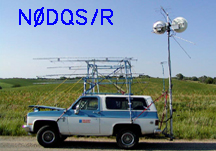
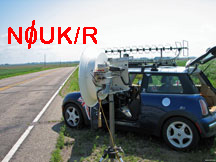
W7XU/R wins the Rover's Corner Award!
It was an awesome 13 grid effort for Arliss and Ed's Microwave debut!
What can I say, “Rover Mania IV” was the key! Here is the chart of Rover activity I worked:
| BAND | W7XU/R | WØZQ/R | NØDQS/R | KØHAC/R | WAØVPJ/R | KCØP/R |
| 222 MHz | 13 | 7 | 4 | 3 | ||
| 432 MHz | 13 | 7 | 4 | 3 | 3 | 2 |
| 902 MHz | 13 | 7 | 4 | 3 | ||
| 1296 MHz | 13 | 7 | 4 | 3 | 2 | 2 |
| 2304 MHz | 13 | 7 | 4 | |||
| 3456 MHz | 13 | 7 | 4 | |||
| 5.7 GHz | 13 | 7 | 4 | |||
| 10 GHz | 13 | 7 | 4 | 3 | ||
| 24 GHz | 4 | |||||
| Total QSOs | 108 | 56 | 32 | 12 | 8 | 4 |
Total Rover QSOs = 220
Rover QSOs % of Total QSOs = 81% WOW! The rovers really were the major key for sure. It was a down 4% from last year, but having W7XU/R in 13 grids really came through! It was an amazing performance from Arliss and Ed for their first big all band microwave rover effort! Jon - WØZQ made it out in grids farther away, so only 7 from him, but never a problem finding him. Gene was back again and running full steam with his blue bomber, but got limited due to the weather.
A special thanks to all the rovers. Without contacts from them, the score would be next to nothing! "Rover Mania IV" was a complete success!
Below is a chart of "Rover Mania III" Rovers.
| BAND | NØDQS/R | WØZQ/R | K9JK/R | NØUK/R | WAØVPJ/R | KCØIYT/R | WBØLJC/R |
| 222 MHz | 12 | 8 | 5 | 2 | 1 | ||
| 432 MHz | 12 | 8 | 7 | 4 | 3 | 2 | 2 |
| 902 MHz | 12 | 8 | |||||
| 1296 MHz | 12 | 8 | 3 | ||||
| 2304 MHz | 12 | 8 | |||||
| 3456 MHz | 12 | 8 | |||||
| 5.7 GHz | 12 | 8 | |||||
| 10 GHz | 12 | 8 | 2 | ||||
| 24 GHz | 6 | ||||||
| Total QSOs | 102 | 64 | 15 | 6 | 5 | 3 | 2 |
Total Rover QSOs = 197
Below is a chart of "Rover Mania II" Rovers.
| BAND | WØZQ/R | KØMHC/R | KØSM/R | NØDQS/R | KCØIYT/R | NØRHL/R | K9JK/R |
| 222 MHz | 12 | 12 | 6 | 4 | 1 | ||
| 432 MHz | 12 | 12 | 12 | 6 | 4 | 1 | |
| 902 MHz | 12 | 12 | 12 | 6 | 3 | 1 | |
| 1296 MHz | 12 | 12 | 2 | 3 | |||
| 2304 MHz | 12 | 12 | 6 | 3 | |||
| 3456 MHz | 12 | 12 | 12 | 6 | 3 | 1 | |
| 5.7 GHz | 12 | 9 | 12 | 6 | |||
| 10 GHz | 12 | 9 | 12 | 6 | 1 | ||
| 24 GHz | 6 | 2 | |||||
| Total QSOs | 102 | 90 | 60 | 46 | 21 | 3 | 1 |
Total Rover QSOs Rover Mania II = 323
Below is a chart of "Rover Mania I" Rovers. As one can see, there were lots more rovers.
|
BAND |
WØZQ/R |
KØNY/R |
KBØTHN/R |
WØAMT/R |
KØSM/R |
KØPG/R |
K9ILT/R |
|
222 MHz |
12 |
10 |
10 |
8 |
|
3 |
3 |
|
432 MHz |
12 |
10 |
10 |
8 |
6 |
3 |
3 |
|
902 MHz |
12 |
6 |
6 |
8 |
|
|
|
|
1296 MHz |
12 |
6 |
6 |
8 |
|
|
|
|
2304 MHz |
12 |
|
|
8 |
|
|
|
|
3456 MHz |
12 |
|
|
8 |
6 |
|
|
|
5760 MHz |
9 |
10 |
10 |
|
|
|
|
|
10 GHz |
12 |
9 |
8 |
|
4 |
|
|
|
24 GHz |
|
|
|
|
4 |
|
|
|
Total QSOs |
93 |
51 |
50 |
48 |
20 |
6 |
6 |
|
BAND |
KFØQ/R |
NØHJZ/R |
KCØP/R |
NØHZO/R |
WBØLJC/R |
|
|
|
222 MHz |
4 |
8 |
|
|
|
|
|
|
432 MHz |
4 |
8 |
1 |
1 |
1 |
|
|
|
902 MHz |
4 |
|
|
|
|
|
|
|
1296 MHz |
4 |
|
1 |
1 |
|
|
|
|
2304 MHz |
4 |
|
|
|
|
|
|
|
3456 MHz |
4 |
|
|
|
|
|
|
|
5760 MHz |
|
|
|
|
|
|
|
|
10 GHz |
|
|
|
|
|
|
|
|
24 GHz |
|
|
|
|
|
|
|
|
Total QSOs |
36 |
16 |
2 |
2 |
1 |
|
|
Total Rover QSOs Rover Mania I = 331
| YEAR | R-QSOS | % | ACTIVITY |
| 2007 | 220 | 81 | FAIR |
| 2006 | 197 | 86 | FAIR |
| 2005 | 323 | 79 | AWESOME!! |
| 2004 | 331 | 91 | AWESOME!! |
| 2003 | 118 | 70 | GOOD |
| 2002 | 71 | 68 | LIGHT |
| 2001 | 52 | 28 | LIGHT |
Above are the chart of the Rover activity over the last number years.
AGAIN THE UHF CONTEST ACTIVITY IS ALIVE AND WELL!!!!
Oh, and for those of you who think this was a big grid circling expedition by all the rovers or captured rover situation, you know the drill - go pound sand! The rovers were all independent entities, and they were not captured rovers until I could find them! They all came up with their own routes and did what they wanted.
GRID CHARTS
For the logging, I used "RoverLog" again... (It's just not for Rovers ya know!) and it worked out very well. I also decided to do a slightly different custom grid map layout. I used the "RoverLog's" notation for indicating the general number of QSOs in a grid to show activity level from each area on each band. "RoverLog" has a map function that shows this as well on the fly so one can check on the QSO density as the contest progresses. The program worked has very well and I will use it again! See www.2ub.org/roverlog
Green Grids are one contact.
Yellow Grids are more than one and less than five contacts.
Red Grids are five or more contacts.
Grids Below are the ones worked from EN13VC - the lower right hand part of EN13...
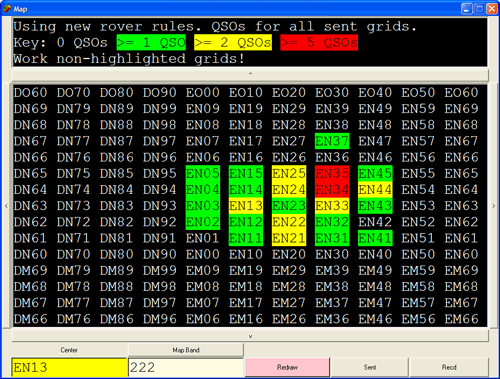
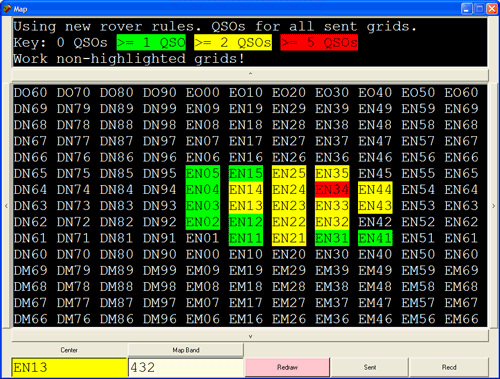
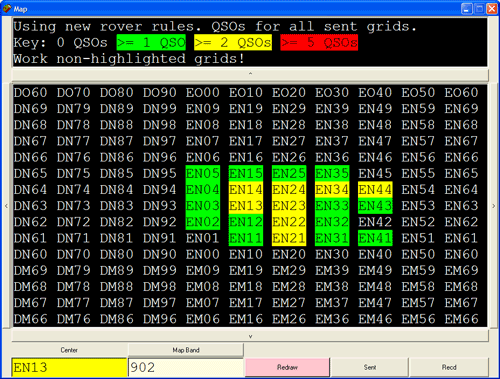

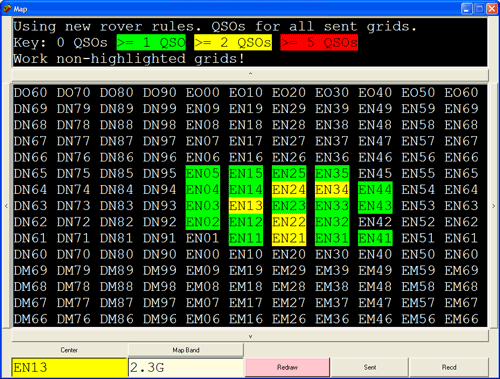
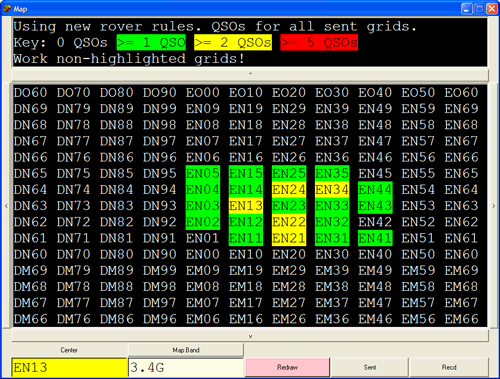
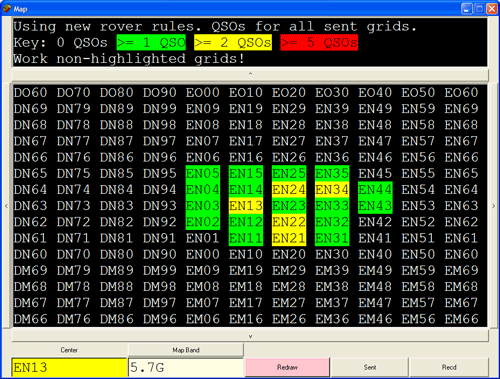


So as one can see from the grid maps, there was only very localized conditions, no contacts out of the general area.
No laser this time again and only 4 grids on 24 GHz.
Well, better propagation next time hopefully - one of these days it will all come together!
73 and See You Next Contest!
Mike - KMØT EN13vc